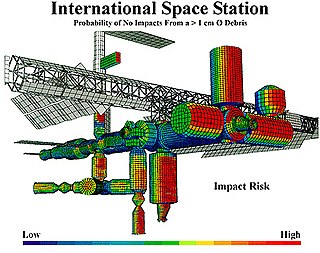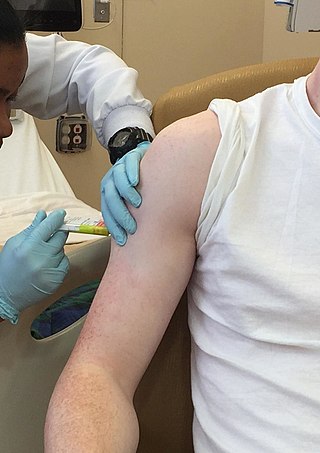
The International Organization for Standardization is an international standard development organization composed of representatives from the national standards organizations of member countries. Membership requirements are given in Article 3 of the ISO Statutes.

Risk management is the identification, evaluation, and prioritization of risks followed by coordinated and economical application of resources to minimize, monitor, and control the probability or impact of unfortunate events or to maximize the realization of opportunities.
Medical physics deals with the application of the concepts and methods of physics to the prevention, diagnosis and treatment of human diseases with a specific goal of improving human health and well-being. Since 2008, medical physics has been included as a health profession according to International Standard Classification of Occupation of the International Labour Organization.

Clinical trials are prospective biomedical or behavioral research studies on human participants designed to answer specific questions about biomedical or behavioral interventions, including new treatments and known interventions that warrant further study and comparison. Clinical trials generate data on dosage, safety and efficacy. They are conducted only after they have received health authority/ethics committee approval in the country where approval of the therapy is sought. These authorities are responsible for vetting the risk/benefit ratio of the trial—their approval does not mean the therapy is 'safe' or effective, only that the trial may be conducted.
Health Level Seven or HL7 refers to a set of international standards for transfer of clinical and administrative data between software applications used by various healthcare providers. These standards focus on the application layer, which is "layer 7" in the OSI model. The HL7 standards are produced by Health Level Seven International, an international standards organization, and are adopted by other standards issuing bodies such as American National Standards Institute and International Organization for Standardization.
Good clinical practice (GCP) is an international quality standard, which governments can then transpose into regulations for clinical trials involving human subjects. GCP follows the International Council for Harmonisation of Technical Requirements for Pharmaceuticals for Human Use (ICH), and enforces tight guidelines on ethical aspects of clinical research.
The Declaration of Helsinki is a set of ethical principles regarding human experimentation developed originally in 1964 for the medical community by the World Medical Association (WMA). It is widely regarded as the cornerstone document on human research ethics.

The Global Reporting Initiative is an international independent standards organization that helps businesses, governments and other organizations understand and communicate their impacts on issues such as climate change, human rights and corruption. GRI provides the world's most widely used sustainability reporting standards.
ISO 13485Medical devices -- Quality management systems -- Requirements for regulatory purposes is a voluntary standard, published by International Organization for Standardization (ISO) for the first time in 1996, and contains a comprehensive quality management system for the design and manufacture of medical devices. The latest version of this standard supersedes earlier documents such as EN 46001 and EN 46002 (1996), the previously published ISO 13485, and ISO 13488.
The ISO/TC 215 is the International Organization for Standardization's (ISO) Technical Committee (TC) on health informatics. TC 215 works on the standardization of Health Information and Communications Technology (ICT), to allow for compatibility and interoperability between independent systems.
A Clinical Research Coordinator (CRC) is a person responsible for conducting clinical trials using good clinical practice (GCP) under the auspices of a Principal Investigator (PI).
The following outline is provided as an overview of and topical guide to clinical research:
The Nordic Institute of Dental Materials AS (NIOM AS) is a Nordic Cooperative Body for dental biomaterials. The Institute’s activities in research, materials testing, standardisation and research-based consulting are directed towards dental health services and health authorities in the Nordic countries. The Institute is owned jointly by NORCE and the Norwegian Ministry of Health and Care Services. Activities are financed by the Nordic Council of Ministers and the Nordic ministries for health services. Materials testing and consulting services also generate income. As a joint Nordic resource center, NIOM collaborates with dental schools and research institutions and provides services to government health authorities, dental professionals, and the public in the Nordic countries in the field of dental biomaterials.
ISO 28000:2022, Security and resilience – Security management systems – Requirements, is a management system standard published by International Organization for Standardization that specifies requirements for a security management system including aspects relevant to the supply chain.
ISO 10218Robots and robotic devices — Safety requirements for industrial robots is an international standard for industrial robot safety, developed by ISO/TC 184/SC 2 "Robots and robotic devices" in parallel with the European Committee for Standardization. It consists of two parts:
ISO 17100:2015 Translation Services-Requirements for Translation Services was published on May 1, 2015. It was prepared by the International Organization for Standardization's Technical Committee ISO/TC 37, Terminology and other language and content resources, Subcommittee SC 5, Translation, interpreting and related technology.
Guidances for statistics in regulatory affairs refers to specific documents or guidelines that provide instructions, recommendations, and standards pertaining to the application of statistical methodologies and practices within the regulatory framework of industries such as pharmaceuticals and medical devices. These guidances serve as a reference for statisticians, researchers, and professionals involved in designing, conducting, analyzing, and reporting studies and trials in compliance with regulatory requirements. These documents embody the prevailing perspectives of regulatory agencies on specific subjects. It is worth noting that in the United States, the term "Guidances" is used, while in Europe, the term "Guidelines" is employed.
ISO 22301:2019, Security and resilience – Business continuity management systems – Requirements, is a management system standard published by International Organization for Standardization that specifies requirements to plan, establish, implement, operate, monitor, review, maintain and continually improve a documented management system to protect against, reduce the likelihood of occurrence, prepare for, respond to, and recover from disruptive incidents when they arise. It is intended to be applicable to all organizations, or parts thereof, regardless of type, size and nature of the organization.
An independent safety officer (ISO) is a clinician or researcher who is independent of the clinical study team and helps to monitor a clinical trial for research participant (patient) safety, adverse events, trial progress, and data quality. An ISO has relevant experience with clinical trials as well as with the patient population and intervention being studied. Clinical trials using an ISO are usually smaller, single-site trials with a moderate to minimal risk intervention.



